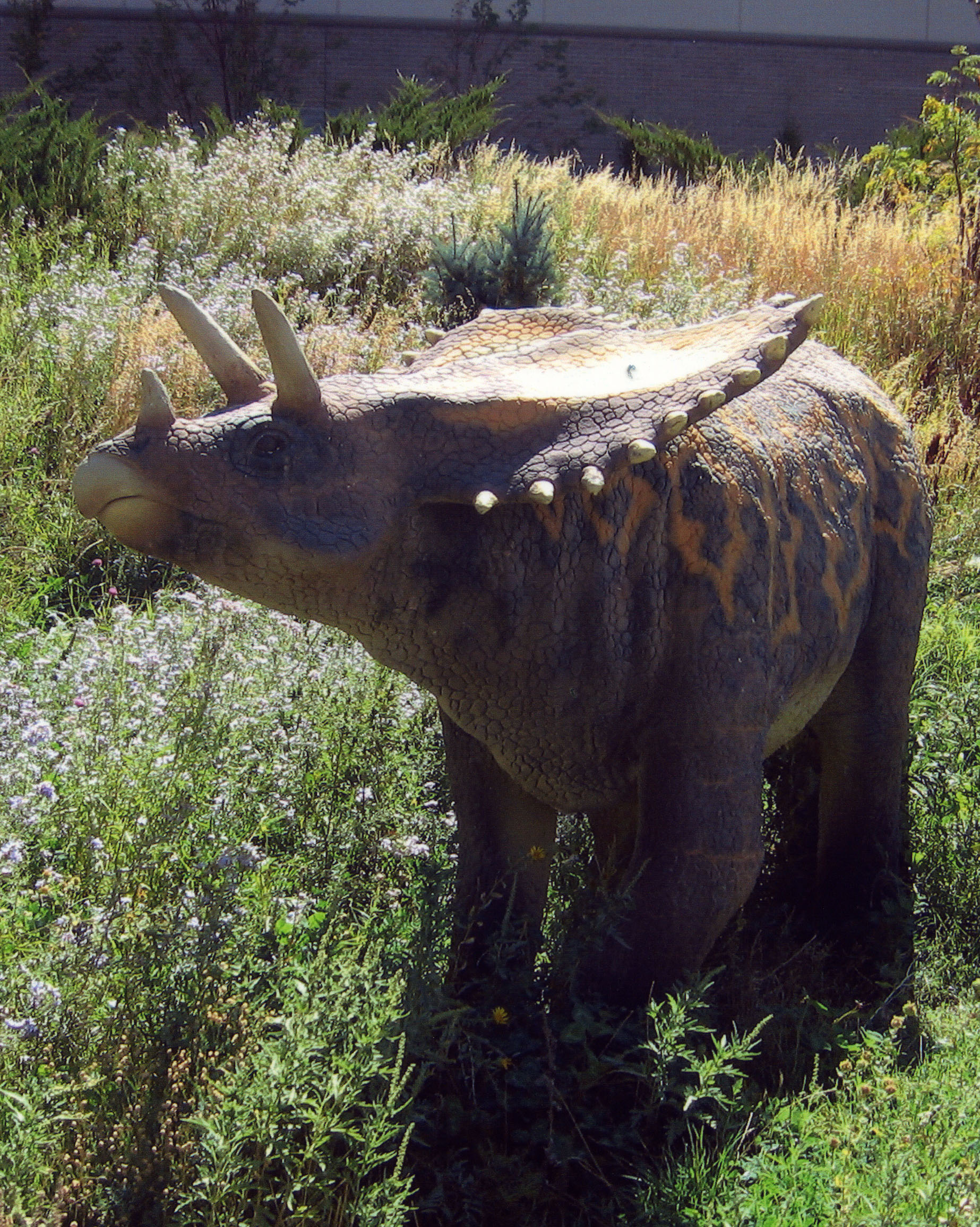
Species: belli, russelli
Range: Late Cretaceous (Santonian-Campanian, 85-70 MYA) from Montana and Alberta, Canada
Size estimate: 14-16 ft length, 1.5-2 tons
Discovery: Lawrence Lambe, 1914
Classification: dinosauria, ornithischia, cerapoda, ceratopsia, chasmosauridae
Since no one has ever seen a living dinosaur, and the missing pieces of the fossil record withhold important clues to their appearance, no artistic representation of a dinosaur ever gets it 100% right. On top of that, new discoveries can change our ideas of extinct creatures drastically. So, how close does this sculpture come to what we know of the original animal?
• Judging by size, this sculpture probably represents a juvenile. It does not, however, show other indicators of youth in the shape of its horns, frill, or body. In other words, it’s a kid-sized adult. Chasmosaurus fossils include one of the few juvenile ceratopsians known, so we have an idea of how its shape changed as it grew to adulthood. Taking Chasmosaurus juvenile features into account, the frill should be about half the length and probably narrower at the top than at its base; the horns should be much shorter—almost just bumps—but keep reading for further discussion on this point; the cheekbones (jugals) should point more downward than outward.
• One juvenile feature which the sculpture does portray correctly concerns the overall profile of the face—it cuts an overall shorter and rounder profile than that of an adult’s, with the chin thicker and rounder but the top still narrow and beaky.
• If we were to ignore size and critique the sculpture as an adult, it would be a really small one. Adults grew a little larger than American Bison—longer and not as tall at the shoulder, of course—so this sculpture would need to pack on another 50% of its size to measure up.
• Baby face and jutting cheeks aside, the head matches an adult’s reasonably well. The horns bear further scrutiny thanks to some taxonomic confusion arising from horn size and shape. Unlike many other ceratopsians, Chasmosaurus bore relatively small horns on both its nose and over its eyes. Some individuals (or perhaps species, according to different studies) bore horns only about as prominent as those seen on the Ceratosaurus nearby. Juvenile’s horns would be even smaller. A few adult and subadult specimens grew longer brow horns that measure roughly the size of the brow horns on this statue, but they curved backwards a little, not ramrod straight like this statue’s.
• Body proportions in a couple of particulars do not match general dinosaur anatomy, let alone Chasmosaurus’ specifically. The forelegs appear to follow a mammalian model, with the musculature suggesting a short shoulder blade and a shoulder joint higher up the torso than usual for dinosaurs.
• The hips likewise measure too short, and they attach to the spine at an odd angle. Ceratopsians in general and Chasmosaurus specifically incorporated an unusual number of vertebrae into their sacra, to which the hips attach. Such heavy-duty reinforcement coincides with a reduction of the tail, signaling a radical departure from the usual dinosaurian mode of walking, which requires a thick tail for pulling the upper leg back. In other words, most dinosaurs walked with their tails, but ceratopsians walked with their hips, like mammals only with a different configuration of the main muscles, leading to huge thighs. Dromaeosaurs (‘raptors) likewise deemphasized their tails for different reasons; they ended up walking with their drumsticks, foreshadowing how birds walk and probably making them pretty fantastic leapers.
• Owing to the discrepancies of the shoulders and hips, this sculpture’s posture does not closely match that of the original animal, but there may be an artistic reason for this. Dinosaur spines tend to arc upwards a little or follow a flat line—no swaybacks here. However, a hole between the shoulders of this sculpture suggests it may have mounted a pole there, making it look and maybe even function like a carousel pony, which does have the mammalian swayback posture. If so, it also explains the smaller size.
• As mentioned before, ceratopsians have wimpy, dangling, mammal-like tails quite unlike the dinosaurian norm. If anything, this sculpture’s tail is too thick, but it is supposed to look roughly like this. Even though they probably curved low, trackway evidence shows they didn’t drag their tails in the mud, but like many other concrete sculptures in the Park, this sculpture probably drags its tail for engineering reasons.
• Ceratopsians used all four of their hind toes for walking; this sculpture bears five. Ceratopsian fingers get more interesting: like many other ornithischian dinosaurs, they retained all five fingers, but only three of them are visible in fossil footprints. Where were the other two? Due to structural constraints on their forelimbs, ceratopsians could not pronate their hands—that is, they could not position them to face their palms backwards without awkwardly flaring their elbows out. Some old illustrations do portray such a posture, and even today scientists debate on exactly how ceratopsian forelimbs work. At any rate, the shapes of the other two fingers and trackway evidence strongly suggest that they were buried in the flesh of the hand and acted together a little like a bony heel. This sculpture presents . . . no fingers! Some of the other statues also leave off the fingers or toes where the statue’s intended display would obscure them, such as the hind feet on the Leptoceratops nearby, which are nearly always surrounded by vegetation. That said, it is a little weird that this sculpture’s hind feet bear toes at all, let alone more toes than they should.
© 2023 Dinosaur Park • All Rights Reserved.